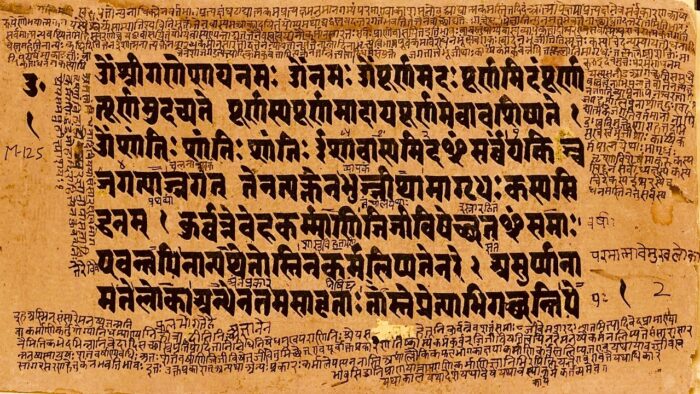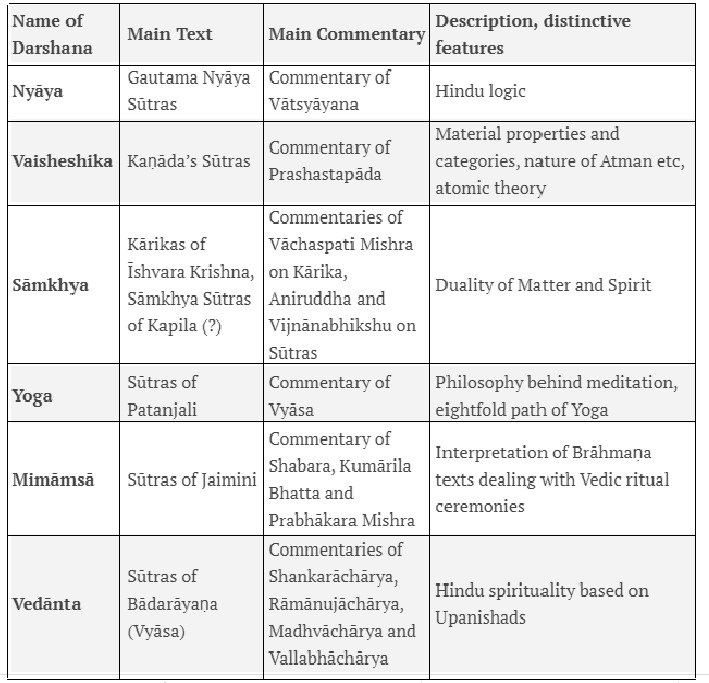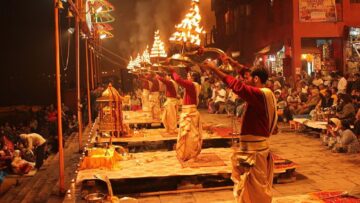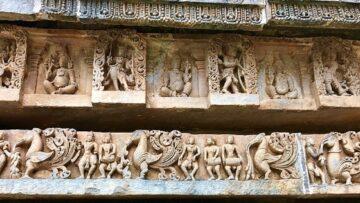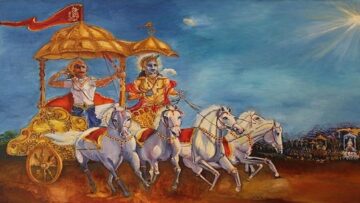Dharmashāstras Or Smritis
The four aims of life are artha (wealth), kāma (desire), dharma (virtue) and moksha (liberation). The literature regarding dharma are the Dharma Shāstras which deal with the laws and regulations governing the social and ethical life of the individual in his society. There are four ways to determine right and wrong – the shruti (Vedas), smriti (dharma shāstras etc.), good conduct and conscience. The moral code is not considered as static – it is to be learned in each generation from what wise men who are good and free from hatred and attachment, declare.
The Dharma Shāstras believes in the four fold order of the society (the chāturvarṇya system popularly known as the “caste system”) which divides the society into four main groups where the hierarchy flows as – the priest (Brahmin), the warrior (kshatriya), the merchant (vaishya) and the laborer (shudra).
The dharma shāstras advocate the āshrama system or the four stages of life for a dvija – the student (brahmachārin), the householder (grihastha), the forest dweller (vānaprastha) and the wandering mendicant (sannyāsin). The purpose of the āshrama system is to enable the dvijas to perform their secular duties in the society and also lead a life conducive to the attainment of moksha.
The prominent or the most important Smritis are those of Manu, Yājñavalkya and Parāshara. Other important Smritis are those by Shankha-Likhita, Harita, Brihaspati, Atri, Daksha, Nārada etc. The Dharma Sūtras belonging to the Kalpa Sūtra collections are sometimes also classified as Smritis.
Traditionally, the Manu Smriti is considered the most complete and authoritative Smriti although a later tradition asserts that the Parāshara Smriti is more valid for modern times. The Hindu personal law in India is largely derived from the Mitāksharā commentary on the Yājñavalkya Smriti, in view of its great popularity in large parts of India during the last few centuries. The Nārada Smriti specializes in legal jurisprudence and deals with these subjects in a very advanced manner (similar to modern works) even though it is almost a 2000 year old recast of an older work!
Āgamas
These are treatises on theology and practical manuals on worship for the different Hindu traditions. Traditionally, the Āgamas are five-fold, aligned with the five major sampradāyas of classical Hinduism:
- Vaishnava Āgamas: These Āgamas are considered authoritative by Hindus who worship the Divinity in the form of Vishnu or his incarnations. These include several subtypes in turn –
- Pāñcharātra Āgamas: They are a collection of several dozen individual scriptures, of which the main ones are three – Sātvata, Paushkara and Jayākhyaya.
- Vaikhānasa Āgamas: They are four in number, and are believed to have been authored by Sages Atri, Marichi, Bhrigu and Kashyapa respectively.
- Bhāgavata: Very few works such as the Sātvata Tantra survive today.
- Shaiva Āgamas: They are 28 in number. The followers of these Āgamas worship Divinity in the form of Shiva. There are two main Sampradāyas of the followers of Shaiva Āgamas:
- Pratyabhijna or Kashmir Shaivism
- Shaiva Siddhānta
- Shākta Āgamas or Tantras: These are a collection of 71 scriptures called Tantras which are considered authoritative together with the Vedas by Hindus who worship Divinity in the form of Shakti – the Universal Mother. The Shaiva and Shākta Āgamas are often considered complimentary because Shakti is the consort of Lord Shiva.
- Saura Āgamas: No works in this category survive. These Āgamas were meant for Hindus who worshipped divinity in the form of Sun.
- Gāṇapatya Āgamas: These were meant for Hindus who worshipped Gaṇapati. Again, no works in this class survive today.
Regarding the purpose of these scriptures, a scholar says –
“The purpose of worship is to lift man from the level of sensibility to that of divinity by making proper use of his very senses. The technique by which this is done has come to be called Tantra in India. The Tantras are the books which initiate the devotee into the technique of worship. They are also known as the Agamas. And, the cults which are based in these Scriptures are usually referred to as Tantric cults.”[1]
Tantras or Āgamas have had a profound impact on the way Hinduism is practiced in our daily lives. Most of our domestic and temple rituals are derived from Tantric teachings. Directions for fasts, vows etc., are also dealt with in the Tantras. In a way, the Āgamas parallel the Vedas (which are also called ‘Nigama’) but the essential differences between the two can be summarized in the following words:
The Tantras are sometimes known as Agamas to differentiate them from the Vedas, which are known as Nigamas. The difference between Agamas and Nigamas is that the Agamas focus on the worship of a deity with form, i.e. Saguna brahaman, while Nigamas focus on the worship of a formless diety, nirguna brahman. Agamas tend to be more exoteric and celebrate the tangible while the Nigamas are esoteric and celebrate the intangible. Agamas give greater value to the emotions that are provoked by the ritual while Nigamas give greater value to the intellectual decoding of the ritual. Agamas approach Prakriti first and then Purusha, while Nigamas approach Purusha first and then Prakriti. In Tantras, Goddess is Shakti or power, to be decoded, while in the Vedas, Goddess is Maya, delusion, to be transcended.[2]
Darshana Shastras
These are six systems of classical Hindu Philosophy and Theology and several other later minor schools of Philosophy. Details of this class of literature will be considered in Class 12.
Non Classical and later schools of philosophy include Pratyabhijna (or Kashmir Shaivism), Shaktism (Agastya Sutra), Bhakti (works of Narada and Shandilya) and so on.
For the last 1000 years or so, the Vedānta Darshana (and in particular, the schools of Shankarāchārya, Rāmānujāchārya, Madhvāchārya and Vallabhāchārya have become the dominant theology and philosophy acceptable to Hindus, with the Nyāya Darshana holding sway in some parts of eastern India. In fact, when Hindus refer to Hindu spirituality, they most commonly mean the Vedānta and its various interpretations of the Upanishads. The Yoga school is also very popular in so far as the practice of meditation is concerned and is gaining considerable popularity in the West.
This does not mean that the other Darshanas are extinct. It is more accurate to say that most of the principles of other Darshanas such as the Sāmkhya, were incorporated into the Vedānta schools.
Devotional Literature
A vast corpus of devotional Hindu literature comprising of hymns (stotras and stavas), individual verses (shlokas) in praise of different Deities, short narratives of incidents from the lives of Hindu saints and sages (kathā and other names), renderings of specific episodes from the Itihāsas and Purāṇas (kathā and other names), glories of holy places (mahātmyas) and so on exist in Sanskrit and other languages spoken by Hindus. Literally dozens of such works are composed every decade by pious Hindus. Some of these works have attained great popularity as well as sanctity over the centuries, and are recited and used in religious ceremonies by Hindus every day. A better account of such works in non-Sanskritic languages is contained in the next section.
[1] T. M. P. Mahadevan, p. 180
[2] Pattanaik (2011), pp. 119-120
Featured Image: wikipedia.org
(This article was published by IndiaFacts in 2018)
Disclaimer: The opinions expressed in this article belong to the author. Indic Today is neither responsible nor liable for the accuracy, completeness, suitability, or validity of any information in the article.

